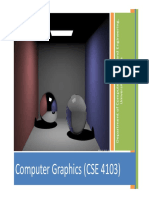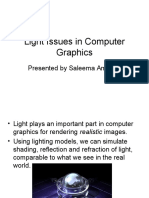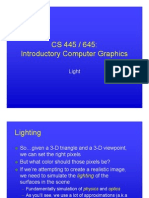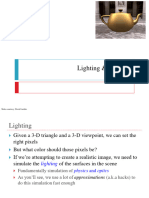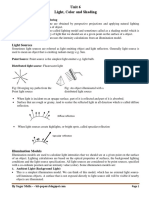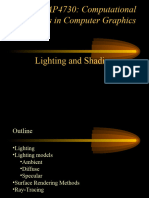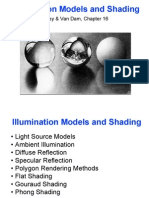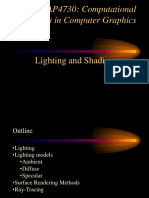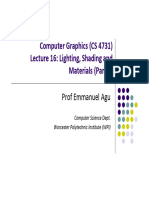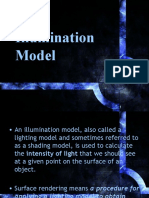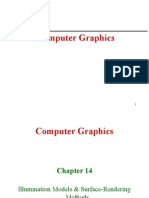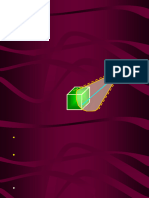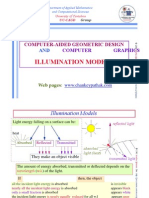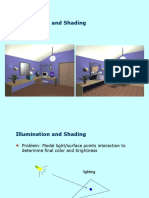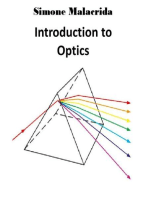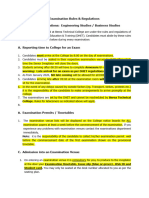0 ratings0% found this document useful (0 votes)
31 viewsLecture 8a
This document discusses illumination models used to calculate the intensity of light reflected at points on surfaces. It describes three components of reflected light: diffuse, which scatters uniformly in all directions; specular, which is mirror-like; and ambient, which represents indirect illumination. Equations are provided for computing the diffuse and specular components using properties of the light source(s), surface normals, view vectors and reflection vectors. The total reflected light is the sum of the ambient, diffuse and specular components.
Uploaded by
s_paraisoCopyright
© © All Rights Reserved
Available Formats
Download as PPT, PDF, TXT or read online on Scribd
0 ratings0% found this document useful (0 votes)
31 viewsLecture 8a
This document discusses illumination models used to calculate the intensity of light reflected at points on surfaces. It describes three components of reflected light: diffuse, which scatters uniformly in all directions; specular, which is mirror-like; and ambient, which represents indirect illumination. Equations are provided for computing the diffuse and specular components using properties of the light source(s), surface normals, view vectors and reflection vectors. The total reflected light is the sum of the ambient, diffuse and specular components.
Uploaded by
s_paraisoCopyright
© © All Rights Reserved
Available Formats
Download as PPT, PDF, TXT or read online on Scribd
You are on page 1/ 20
Illumination Models
CMSC 161: Interactive Computer
Graphics
Introduction
In order to produce realistic images, we must simulate
the appearance of surfaces under various lighting
conditions.
Light Sources
The total reflected light is the sum of the contributions
from light sources and other reflecting surfaces in the
scene
Point Source
Parallel Source
Distributed Light Source
A
B
C
Light Sources
When light strikes a surface, some of the light are
reflected, some are absorbed, and some are transmitted.
The intensity of the color of the surface depends on how
much light is reflected.
The amount of incident light reflected by a surface
depends on the type of material: shiny materials reflect
more light and dull surfaces absorb more of the incident
light.
Illumination Models
Illumination models are used to calculate the intensity
of light that is reflected at a given point on a surface.
They describe the interaction between the light sources
and the surfaces.
Two Kinds of Reflection
Diffuse reflection occurs when some
incident light slightly penetrates the
surface and is retransmitted uniformly in
all directions
Specular reflection
Are mirror-like and highly directional
Incident light does not penetrate the
surface but instead is reflected
directly
This gives rise to highlights that make
the surface look shiny
Specularly reflected light has the
same color as the incident light
Total Light Reflected
total light reflected = diffuse component + specular
component
Computing the Diffuse Component
Lamberts Law
Suppose that a beam of light coming from the direction vector L
strikes a surface with normal vector N at an angle .
Then, the amount of diffuse reflection depends on .
When the angle is increased,
The surface area lighted increases
The energy per unit area (or intensity) decreases
Computing the Diffuse Component
Diffuse component = I
s
k
d
cos where
I
s
is the intensity of the light source
k
d
is the diffuse reflection coefficient of the surface (0 k
d
1)
0 / 2
Assuming that vectors N and L are normalized, cos = N L, so
Diffuse component = I
s
k
d
(N L)
Computing the Specular Component
Let be the angle between the reflection vector R and the view
vector V. As increases, the intensity of light reflected in the V
direction increases.
The figure below shows the case for an imperfect reflector.
Computing the Specular Component
Phong Illumination model (for nonperfect reflectors)
Specular component = I
s
k
s
cos
n
where
I
s
is the intensity of the light source
k
s
is the specular reflection coefficient (0 k
s
1)
n is the specular-reflection exponent, which determines the rate of
falloff of light
Computing the Specular Component
Assuming that R and V have been normalized, cos = R V, so
Specular component = I
s
k
s
(R V)
n
By simple geometry, R = 2N(N L) L
Approximation of attenuation by the form cos
n
has no real
physical basis, but it looks good.
Total Light Reflected I
I = diffuse component + specular component
I = [I
s
k
d
(N L)] + [I
s
k
s
(R V)
n
]
I = I
s
[k
d
(N L) + k
s
(R V)
n
]
Ambient Light
An illumination model can be expressed by an illumination
equation in variables associated with the point on the object being
shaded. The illumination equation that expresses this simple
model is
I = k
i
where I is the resulting intensity and coefficient k
i
is the objects
intrinsic intensity
The process of evaluating the illumination equation at one or more
points on an object is often referred to as lighting the object.
Now imagine, instead of self-luminosity, that there is a diffuse,
nondirectional source of light, the product of multiple reflections of
light from the many surfaces in the environment.
This is known as ambient light.
Direct and Indirect Illumination
Computation of light reflected as a result of indirect illumination is
expensive, so, we can just ignore its computation and instead add
an ambient component to compensate it.
Ambient component = I
a
k
a
where
I
a
is the intensity of the ambient light
k
a
is the ambient coefficient (0 k
a
1)
Total Light Reflected I
total light reflected I = ambient + diffuse + specular components
I = I
a
k
a
+ I
s
[k
d
(N L) + k
s
(R V)
n
]
Additional remarks:
To deal with colors, we compute the intensity for the red, green and blue
components
To handle multiple light sources, we sum the intensity contributions from
each light source
Examples ...
Ambient Lighting
Diffuse Lighting
Specular Lighting
You might also like
- Light Issues in Computer Graphics: Presented by Saleema AmershiNo ratings yetLight Issues in Computer Graphics: Presented by Saleema Amershi30 pages
- Light Issues in Computer Graphics: Presented by Saleema AmershiNo ratings yetLight Issues in Computer Graphics: Presented by Saleema Amershi30 pages
- CS 445 / 645: Introductory Computer Graphics: LightNo ratings yetCS 445 / 645: Introductory Computer Graphics: Light34 pages
- Computational Structures in Computer Graphics: Lighting and ShadingNo ratings yetComputational Structures in Computer Graphics: Lighting and Shading44 pages
- Unit 6 Light, Color and Shading - CG - PUNo ratings yetUnit 6 Light, Color and Shading - CG - PU7 pages
- Illumination Models & Surface-Rendering Methods67% (3)Illumination Models & Surface-Rendering Methods42 pages
- Powerpoint For Refraction Lenses and Color - RevNo ratings yetPowerpoint For Refraction Lenses and Color - Rev28 pages
- Phong Reflection Model: Understanding Light Interactions in Computer VisionFrom EverandPhong Reflection Model: Understanding Light Interactions in Computer VisionNo ratings yet
- C A S U P M: Course Code: CMSC 123 Course Name: Data Structures Credit: Prerequisite: Course DescriptionNo ratings yetC A S U P M: Course Code: CMSC 123 Course Name: Data Structures Credit: Prerequisite: Course Description2 pages
- Shading Models For Polygonal Objects: CMSC 161: Interactive Computer GraphicsNo ratings yetShading Models For Polygonal Objects: CMSC 161: Interactive Computer Graphics17 pages
- Color Models and Color Applications: CMSC 161: Interactive Computer GraphicsNo ratings yetColor Models and Color Applications: CMSC 161: Interactive Computer Graphics25 pages
- Visible Surface Determination: CMSC 161: Interactive Computer GraphicsNo ratings yetVisible Surface Determination: CMSC 161: Interactive Computer Graphics34 pages
- Shading Models For Polygonal Objects: CMSC 161: Interactive Computer GraphicsNo ratings yetShading Models For Polygonal Objects: CMSC 161: Interactive Computer Graphics17 pages
- The Quest For Visual Realism: CMSC 161: Interactive Computer GraphicsNo ratings yetThe Quest For Visual Realism: CMSC 161: Interactive Computer Graphics10 pages
- 571470-29 Linear Encoders For Numerically Controlled Machine ToolsNo ratings yet571470-29 Linear Encoders For Numerically Controlled Machine Tools60 pages
- Computers Are An Integral Part of Our LivesNo ratings yetComputers Are An Integral Part of Our Lives11 pages
- Coherence in The Quran and A Brief Analysis of Sura Al BaqarahNo ratings yetCoherence in The Quran and A Brief Analysis of Sura Al Baqarah52 pages
- Review of "An Economic Analysis of A Drug-Selling Gang's Finances" by Steven D. Levitt and Sudhir Alladi VenkateshNo ratings yetReview of "An Economic Analysis of A Drug-Selling Gang's Finances" by Steven D. Levitt and Sudhir Alladi Venkatesh2 pages
- CE8394 Fluid Mechanics and Machinery MCQNo ratings yetCE8394 Fluid Mechanics and Machinery MCQ39 pages
- The Design of A Garment Requires InnovationNo ratings yetThe Design of A Garment Requires Innovation4 pages
- Ministry of Interior: Airport Passports and Security DepartmentNo ratings yetMinistry of Interior: Airport Passports and Security Department1 page
- Budapest Ceenet 2001 - Satellite CommunicationsNo ratings yetBudapest Ceenet 2001 - Satellite Communications93 pages
- (Ebook) Dark Goddess Craft: A Journey Through the Heart of Transformation by Woodfield, Stephanie ISBN 9780738752563, 9780738754079, 0738752568, 0738754072 all chapter instant downloadNo ratings yet(Ebook) Dark Goddess Craft: A Journey Through the Heart of Transformation by Woodfield, Stephanie ISBN 9780738752563, 9780738754079, 0738752568, 0738754072 all chapter instant download65 pages
- Light Issues in Computer Graphics: Presented by Saleema AmershiLight Issues in Computer Graphics: Presented by Saleema Amershi
- Light Issues in Computer Graphics: Presented by Saleema AmershiLight Issues in Computer Graphics: Presented by Saleema Amershi
- CS 445 / 645: Introductory Computer Graphics: LightCS 445 / 645: Introductory Computer Graphics: Light
- Computational Structures in Computer Graphics: Lighting and ShadingComputational Structures in Computer Graphics: Lighting and Shading
- Phong Reflection Model: Understanding Light Interactions in Computer VisionFrom EverandPhong Reflection Model: Understanding Light Interactions in Computer Vision
- C A S U P M: Course Code: CMSC 123 Course Name: Data Structures Credit: Prerequisite: Course DescriptionC A S U P M: Course Code: CMSC 123 Course Name: Data Structures Credit: Prerequisite: Course Description
- Shading Models For Polygonal Objects: CMSC 161: Interactive Computer GraphicsShading Models For Polygonal Objects: CMSC 161: Interactive Computer Graphics
- Color Models and Color Applications: CMSC 161: Interactive Computer GraphicsColor Models and Color Applications: CMSC 161: Interactive Computer Graphics
- Visible Surface Determination: CMSC 161: Interactive Computer GraphicsVisible Surface Determination: CMSC 161: Interactive Computer Graphics
- Shading Models For Polygonal Objects: CMSC 161: Interactive Computer GraphicsShading Models For Polygonal Objects: CMSC 161: Interactive Computer Graphics
- The Quest For Visual Realism: CMSC 161: Interactive Computer GraphicsThe Quest For Visual Realism: CMSC 161: Interactive Computer Graphics
- 571470-29 Linear Encoders For Numerically Controlled Machine Tools571470-29 Linear Encoders For Numerically Controlled Machine Tools
- Coherence in The Quran and A Brief Analysis of Sura Al BaqarahCoherence in The Quran and A Brief Analysis of Sura Al Baqarah
- Review of "An Economic Analysis of A Drug-Selling Gang's Finances" by Steven D. Levitt and Sudhir Alladi VenkateshReview of "An Economic Analysis of A Drug-Selling Gang's Finances" by Steven D. Levitt and Sudhir Alladi Venkatesh
- Ministry of Interior: Airport Passports and Security DepartmentMinistry of Interior: Airport Passports and Security Department
- (Ebook) Dark Goddess Craft: A Journey Through the Heart of Transformation by Woodfield, Stephanie ISBN 9780738752563, 9780738754079, 0738752568, 0738754072 all chapter instant download(Ebook) Dark Goddess Craft: A Journey Through the Heart of Transformation by Woodfield, Stephanie ISBN 9780738752563, 9780738754079, 0738752568, 0738754072 all chapter instant download





